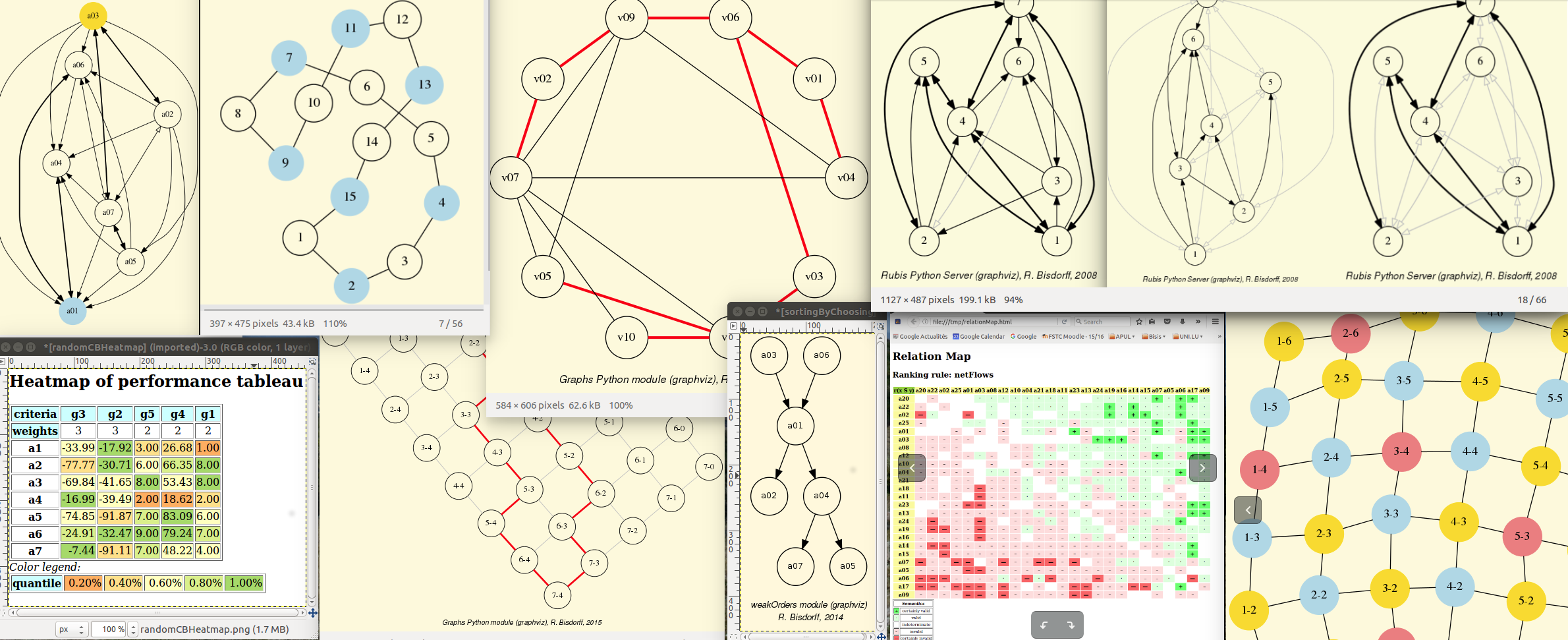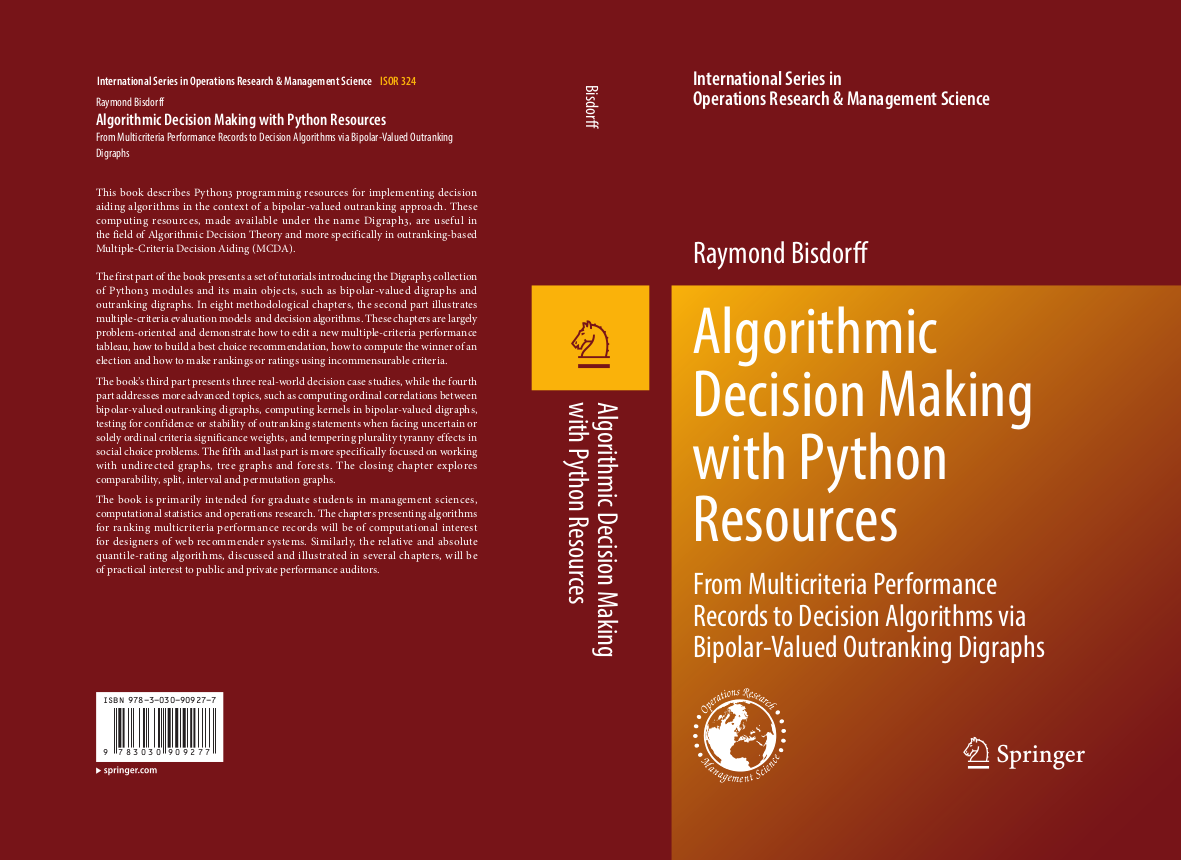Python resources for Algorithmic Decision Theory
Wecome! This is the documentation for the Digraph3 Python programming resources.
- Author:
Raymond Bisdorff, Emeritus Professor of Applied Mathematics and Computer Science, University of Luxdembourg
- Url:
- Version:
Python 3.12 (release: 3.12.3)
- Copyright:
Bisdorff © 2013-2024

Parts of the documentation
- New:
A series of tutorials for tackling large and big outranking digraphs: see Working with big outranking digraphs
A
pairingsmodule for solving pairing problems illustrated with two tutorials on computing fair intergroup and intragroup pairing solutions
-
Start here
-
Technical documentation and source code of all Digraph3 modules
Pearls of bipolar-valued epistemic logic
Advanced theoretical and computational topics-
Algorithimc Decision Theory Lectures
2x2 reduced copies of the presentation slidesComputational Statistics Lectures
2x2 reduced copies of the presentation slides-
Historical case studies and example graphs
Indices and search results
-
All classes, functions and terms
-
Quick access to all the Digraph3 modules
-
Results of current search request
Introduction
This documentation is dedicated toour colleague and dear friendthe late Prof. Marc ROUBENS
The Digraph3 documentation, available on the Read The Docs site: https://digraph3.readthedocs.io/en/latest/, describes the Python3 resources for implementing decision algorithms via bipolar-valued outranking digraphs [1]. These computing resources are useful in the field of Algorithmic Decision Theory and more specifically in the field of Multiple-Criteria Decision Aiding [2]. They provide practical tools for a Master Course on Algorithmic Decision Theory taught at the University of Luxembourg.
The documentation contains, first, a set of tutorials introducing the main objects like digraphs, outranking digraphs and performance tableaux. There is also a tutorial provided on undirected graphs. Some tutorials are problem oriented and show how to compute the winner of an election, how to build a best choice recommendation, or how to linearly rank or rate with multiple incommensurable performance criteria. The tutorial about split, interval and permutation graphs is inspired by Martin Golumbic ‘s book on Algorithmic Graph Theory and Perfect Graphs [3]. We also provide a tutorial on tree graphs and spanning forests. Recently added, the reader may find two tutorials on fairly solving inter-, respectively intragroup pairing problems.
The second Section concerns the extensive reference manual of the collection of provided Python3 modules, classes and methods. The main classes in this collection are the digraphs.Digraph overall root class, the perfTabs.PerformanceTableau class and the outrankingDigraphs.BipolarOutrankingDigraph class. The technical documentation also provides insight into the complete source code of all modules, classes and methods.
The third Section exhibits some pearls of bipolar-valued epistemic logic that enrich the Digraph3 resources. These short topics illustrate well the very computational benefit one may get when working in a bipolar-valued logical framework. And, more specifically, the essential part the logically neutral undeterminate value is judiciously playing therein.
The fourth and fifth sections provide 2x2-reduced notes of the author’s lectures on Algorithmic Decision Theory and Computational Statistics given at the University of Luxembourg in Autumn 2019 and Spring 2020.
The last section gathers historical case studies with example digraphs compiled before 2006 and concerning the early development of tools and methods for enumerating non isomorphic maximal independent sets in undirected graphs and computing digraph kernels.
References
Bisdorff (Feb 2022). Algorithmic Decision Making with Python Resources: From multicriteria performance records to decision algorithms via bipolar-valued outranking digraphs. Springer Verlag Heidelberg, International Series in Operations Research & Management Science ISOR 324, ISBN 978-3-030-90927-2, xli, 346 pages (see https://doi.org/10.1007/978-3-030-90928-4).
Bisdorff, L.C. Dias, P. Meyer, V. Mousseau and M. Pirlot (Eds.) (2015). Evaluation and decision models with multiple criteria: Case studies. Springer-Verlag Berlin Heidelberg, International Handbooks on Information Systems, ISBN 978-3-662-46815-9, 643 pages.
Ch. Golumbic (2004), Algorithmic Graph Theory and Perfect Graphs 2nd Ed., Annals of Discrete Mathematics 57, Elsevier.
